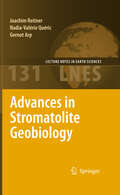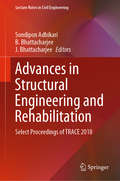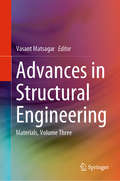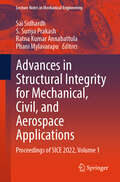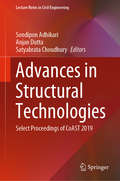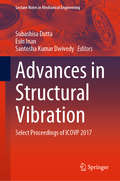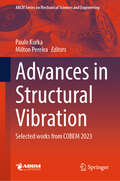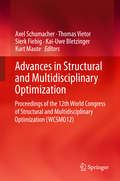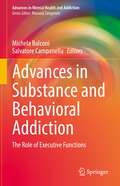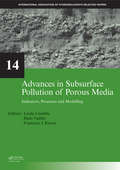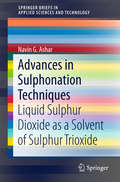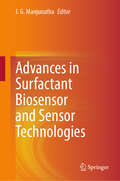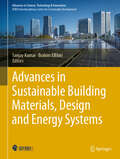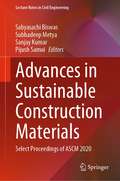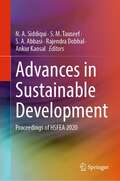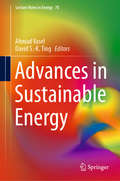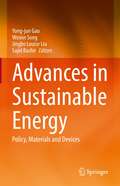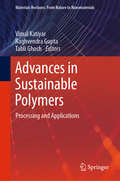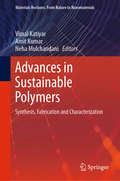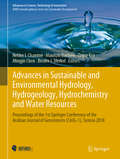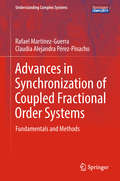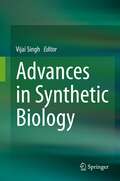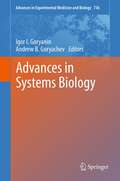- Table View
- List View
Advances in Stromatolite Geobiology (Lecture Notes in Earth Sciences #131)
by Joachim Reitner Gernot Arp Nadia-Valérie QuéricStromatolites are the most intriguing geobiological structures of the entire earth history since the beginning of the fossil record in the Archaean. Stromatolites and microbialites are interpreted as biosedimentological remains of biofilms and microbial mats. These structures are important environmental and evolutionary archives which give us information about ancient habitats, biodiversity, and evolution of complex benthic ecosystems. However, many geobiological aspects of these structures are still unknown or only poorly understood. The present proceedings highlight the new ideas and information on the formation and environmental setting of stromatolites presented at the occasion of the Kalkowsky Symposium 2008, held in Göttingen, Germany.
Advances in Structural Engineering and Rehabilitation: Select Proceedings of TRACE 2018 (Lecture Notes in Civil Engineering #38)
by Sondipon Adhikari B. Bhattacharjee J. BhattacharjeeThis book comprises select papers presented at the International Conference on Trends and Recent Advances in Civil Engineering (TRACE 2018). The book covers a wide range of topics related to recent advancements in structural engineering, structural health monitoring, rehabilitation and retrofitting of structures, and earthquake-resistant structures. Based on case studies and laboratory investigations, the book highlights latest techniques and innovative methods for building repair and maintenance. Recent development in materials being used in structural rehabilitation and retrofitting is also discussed. The contents of this book can be useful for researchers and professionals working in structural engineering and allied areas.
Advances in Structural Engineering: Materials, Volume Three
by Vasant MatsagarThe book presents research papers presented by academicians, researchers, and practicing structural engineers from India and abroad in the recently held Structural Engineering Convention (SEC) 2014 at Indian Institute of Technology Delhi during 22 - 24 December 2014. The book is divided into three volumes and encompasses multidisciplinary areas within structural engineering, such as earthquake engineering and structural dynamics, structural mechanics, finite element methods, structural vibration control, advanced cementitious and composite materials, bridge engineering, and soil-structure interaction. Advances in Structural Engineering is a useful reference material for structural engineering fraternity including undergraduate and postgraduate students, academicians, researchers and practicing engineers.
Advances in Structural Integrity for Mechanical, Civil, and Aerospace Applications: Proceedings of SICE 2022, Volume 1 (Lecture Notes in Mechanical Engineering)
by Phani Mylavarapu Sai Sidhardh S. Suriya Prakash Ratna Kumar AnnabattulaThis book presents select proceedings of the 4th Structural Integrity Conference and Exhibition (SICE-2022), organized at the Indian Institute of Technology, Hyderabad. This book includes chapters written by eminent scientists and academicians broadly working in aerospace, civil, and mechanical and materials engineering within the areas of structural integrity, life prediction, and condition monitoring. These chapters are classified under the domains of aerospace, fracture mechanics, fatigue, civil structures, experimental techniques, computation mechanics, molecular dynamics and nanostructures, smart materials, energy impact, dynamics, mechanisms, structural optimization, composites, AI/ML applications, additive and advanced manufacturing, bio-engineering, structural health monitoring, nondestructive testing, and damage and failure analysis. The book can be a valuable reference for researchers, students and practicing engineers.
Advances in Structural Technologies: Select Proceedings of CoAST 2019 (Lecture Notes in Civil Engineering #81)
by Sondipon Adhikari Anjan Dutta Satyabrata ChoudhuryThis book comprises select proceedings of the National Conference on Advances in Structural Technology (CoAST 2019). It brings together different applied and technological aspects of structural engineering. The main topics covered in this book include solid mechanics, composite structures, fluid-structure interaction, soil-structure interaction, structural safety, and structural health monitoring. The book also focuses on emerging structural materials and the different behavior of civil, mechanical, and aerospace structural systems. Given its contents, this book will be a useful reference for researchers and practitioners working in structural safety and engineering.
Advances in Structural Vibration: Select Proceedings of ICOVP 2017 (Lecture Notes in Mechanical Engineering)
by Subashisa Dutta Santosha Kumar Dwivedy Esin InanThis book consists of selected and peer-reviewed papers presented at the 13th International Conference on Vibration Problems (ICOVP 2017). The topics covered in this book include different structural vibration problems such as dynamics and stability under normal and seismic loading, and wave propagation. The book also discusses different materials such as composite, piezoelectric, and functionally graded materials for improving the stiffness and damping properties of structures. The contents of this book can be useful for beginners, researchers and professionals interested in structural vibration and other allied fields.
Advances in Structural Vibration: Selected works from COBEM 2023 (Lecture Notes in Mechanical Engineering)
by Paulo Kurka Milton PereiraThis book is a compilation of selected works presented at COBEM 2023, emphasizing the field of dynamics and vibrations. It showcases a diverse array of cutting-edge research, ranging from the investigation of metastructures for vibration attenuation in crankshafts to the application of metamaterials for reducing wind tower vibrations. Each chapter offers unique insights and advancements in structural dynamics and vibrations. With contributions encompassing experimental investigations, analytical studies, and practical applications, this book is an invaluable resource for researchers, engineers, and practitioners in the field.
Advances in Structural and Multidisciplinary Optimization: Proceedings of the 12th World Congress of Structural and Multidisciplinary Optimization (WCSMO12)
by Axel Schumacher Thomas Vietor Sierk Fiebig Kai-Uwe Bletzinger Kurt MauteThe volume includes papers from the WSCMO conference in Braunschweig 2017 presenting research of all aspects of the optimal design of structures as well as multidisciplinary design optimization where the involved disciplines deal with the analysis of solids, fluids or other field problems. Also presented are practical applications of optimization methods and the corresponding software development in all branches of technology.
Advances in Substance and Behavioral Addiction: The Role of Executive Functions (Advances in Mental Health and Addiction)
by Salvatore Campanella Michela BalconiThis book deals with recent perspectives on the panel of addiction behavior in a vast amount of population (young and adult). Thanks to the contribution of experts of the topic of addiction the volume will furnish new perspectives to formulate assessment, diagnosis and intervention in response to the increasing variety of addictions. It focuses the assessment of executive functions in substance and behavioral addictions. More specifically, this assessment consists of a new approach not only inherent to the diagnosis, but also to the treatment and prevention of addictions. In fact, there is a strict relationship between executive functions (EF) and addictive behavior: EF plays a remarkable role in significant phenomena for the treatment of addictions, such as craving, relapse and compliance to treatment.
Advances in Subsurface Pollution of Porous Media - Indicators, Processes and Modelling: IAH selected papers, volume 14 (IAH - Selected Papers on Hydrogeology)
by Lucila Candela Francisco Javier Elorza Iñaki VadilloAdvances in Subsurface Contamination of Porous Media: Indicators, Processes and Modelling provides a high level understanding of the processes concerning common and emergent contaminants through their passage from soil to groundwater. The book presents new methodologies and indicators to reach a better understanding of biogeochemical proc
Advances in Sulphonation Techniques: Liquid Sulphur Dioxide as a Solvent of Sulphur Trioxide (SpringerBriefs in Applied Sciences and Technology #151)
by Navin G. AsharThis book presents a complete, in-depth analysis for on the impact of liquid sulfur dioxide and liquid sulfur trioxide to carry out complex and difficult sulfonations, as well as manufacture of sulfuric acid with a CAPEX requirement of less than half, an area requirement less than one-third, and no emission of sulfur dioxide. The processes described in this volume represents an innovative approach relevant to the current manufacturing processes of sulfuric acid, sulfamic acid, para toluene sulfonic acid and other sulfonated product.
Advances in Surfactant Biosensor and Sensor Technologies
by J. G. ManjunathaThis book presents an overview of the development and applications of surfactant biosensor technologies. The progress in this field is fueled by a need for efficient, low cost, stable sensors that utilize harmless materials; this book illustrates how surfactant sensors represent a timely solution to this issue. Readers will learn how to utilize surfactants to make green electrochemical sensors with high stability, sensitivity, selectivity, and a robust, fast response, with special emphasis given to the most recent advances in this field. The book additionally details how to apply these sensors in routine analyses authored by experts in their respective fields. Contributing authors pay close attention to the use of surfactant-based electrochemical sensors in electrodes and devices, examining their applications towards a variety of medicinal, industrial, and environmental applications. This book is an important resource for scientific researchers both specifically in the electrochemistry field, and also for those in interdisciplinary chemistry, biology, physics, and electronics fields. It invites scientists from all areas to participate, with the goal of producing more researchers developing innovative sensor technologies. It will also be beneficial for students and future scientists working on sustainable sensors.
Advances in Sustainable Aviation
by C. Ozgur Colpan Tahir Hikmet Karakoç Yasin ŞöhretThis book provides different engineering, management, economic solutions and methodologies regarding sustainable aviation, giving readers a great sense of how sustainable aviation works at the "systems" level. The aviation industry is one of the fastest growing in the world and can make a positive contribution to sustainability. This book presents environmental policies and their application to the aviation industry and evaluates solutions provided to address pollution. Chapters discuss novel technologies that the aviation industry can apply to reduce its environmental impact and become more energy efficient.
Advances in Sustainable Building Materials, Design and Energy Systems (Advances in Science, Technology & Innovation)
by Sanjay Kumar Brahim ElBhiriThis book is a great opportunity to make the research community discuss the dangerous environmental challenges such as climate change and its huge effects in addition to the world's reliance on fossil fuel and non-renewable resources. In recent years, the authors have been focused on the advancements of technology and how it can improve our lives, but the authors often overlook the fact that it is creating an unsustainable approach that comes at a high cost which makes a sustainable approach to cities necessary, focusing on accessible public transport, energy, water, and food security, and regenerating compact fabric areas. To discuss how to reach this sustainable approach, IEREK held the Advances in Energy Research, Materials Science and Built Environment (EMBE) conference from October 3 to 4, 2024, with attendees from all over the world. It provides an opportunity to exchange ideas and solutions on urban planning, sustainable architecture, climate change mitigation, and innovative design. The EMBE conference hosts a variety of knowledgeable keynote speakers and researchers who discussed the integration of technology in sustainable urban planning, green urbanism, preservation of coastal areas, innovative renewable materials, and responsive architecture. The book covers a wide range of scientific knowledge that can lead humanity toward a sustainable and greener future.
Advances in Sustainable Concrete for Construction
by Alireza BahramiThis book offers groundbreaking insights into transforming the concrete industry with innovative, environmentally conscious solutions. It explores the latest advancements in sustainable technologies, including climate-improved concrete, green binders, recycled materials, and high-performance composites. It also covers the optimization of reinforced concrete structures, load-bearing columns and beams replacements, as well as non-destructive testing methods for predicting concrete performance. Additionally, it investigates engineered cementitious composites, internally cured concrete, and industrial by-products to address pressing environmental challenges in construction. An indispensable reference for engineers, architects, and researchers shaping the future of sustainable infrastructure and reducing carbon footprints
Advances in Sustainable Construction Materials: Select Proceedings of ASCM 2020 (Lecture Notes in Civil Engineering #124)
by Sanjay Kumar Pijush Samui Sabyasachi Biswas Subhadeep MetyaThis book presents select proceedings of National Conference on Advances in Sustainable Construction Materials (ASCM 2020) and examines a range of durable, energy-efficient, and next-generation construction materials produced from industrial wastes and by-products. The topics covered include sustainable materials and construction, innovations in recycling concrete, green buildings and innovative structures, utilization of waste materials in construction, geopolymer concrete, self-compacting concrete by using industrial waste materials, nanotechnology and sustainability of concrete, environmental sustainability and development, recycling solid wastes as road construction materials, emerging sustainable practices in highway pavements construction, plastic roads, pavement analysis and design, application of geosynthetics for ground improvement, sustainability in offshore geotechnics, green tunnel construction technology and application, ground improvement techniques and municipal solid waste landfill. Given the scope of contents, the book will be useful for researchers and professionals working in the field of civil engineering and especially sustainable structures and green buildings.
Advances in Sustainable Development: Proceedings of HSFEA 2020
by S. M. Tauseef S. A. Abbasi N. A. Siddiqui Rajendra Dobhal Ankur KansalThis book comprises selected papers on advances in the field of health and environment safety that were presented at the International Conference on Advances in the field of Health, Safety, Fire, Environment, Allied sciences and engineering (HSFEA 2020). This book presents a number of research papers which focuses on basic concept of sustainable development and its role in modern world for clean development technology. The book also presents methods that can be used to effectively monitor and measure climate change and global warming. Further, the contents of this work stress the importance of maintaining safety and healthy work environments that are free of occupational health hazards. This book will be of interest to researchers, professionals, and policy makers alike.
Advances in Sustainable Energy (Lecture Notes in Energy #70)
by Ahmad Vasel David S-K. TingThis book reveals key challenges to ensuring the secure and sustainable production and use of energy resources, and provides corresponding solutions. It discusses the latest advances in renewable energy generation, and includes studies on climate change and social sustainability. In turn, the book goes beyond theory and describes practical challenges and solutions associated with energy and sustainability. In particular, it addresses: · renewable energy conversion technologies; · transmission, storage and consumption; · green buildings and the green economy; and · waste and recycling. The book presents the current state of knowledge on renewable energy and sustainability, supported by detailed examples and case studies, making it not only a cutting-edge source of information for experts and researchers in the field, but also an educational tool for related undergraduate and graduate courses.
Advances in Sustainable Energy: Policy, Materials and Devices
by Sajid Bashir Jingbo Louise Liu Yong-Jun Gao Weixin SongThis books provides a comprehensive platform to the scientific, education and research communities working on various fields related to sustainable energy. It covers the exploration, generation and application of this area to meet societal needs as well as addressing global issues related to the environment. The content of this book presents research related to energy and how to tackle climate change as a comprehensive framework based on the success of the Millennium Development Goals (MDGs). The authors use the scientific method to analyze and deliver viable technical solutions, demonstrating how chemistry and engineering can be combined to solve technically challenging problems. While maintaining high scientific rigor, a quantitative approach is offered in select chapters to the study of energy related to our societies increasing need for electrical and chemical energy feedstocks.
Advances in Sustainable Polymers: Processing and Applications (Materials Horizons: From Nature to Nanomaterials)
by Vimal Katiyar Raghvendra Gupta Tabli GhoshThis book provides a systematic overview of the processing and applications of sustainable polymers. The volume covers recent advances in biomedical, food packaging, fuel cell, membrane, and other emerging applications. The book begins by addressing different sections of biomedical application including use of carbohydrate-based therapeutics, nanohybrids, nanohydrogels, bioresorbable polymers and their composites, polymer-grafted nanobiomaterials for biomedical devices and implants, nanofibres, and others. The second part of this book discusses various processing and packaging materials for food packaging applications. The last section discusses other emerging applications, including using microbial fuel cells for waste water treatment, microfluidic fuel cells for low power applications, among others. This volume will be relevant to researchers working to improve the properties of bio-based materials for their advanced application and wide commercialization.
Advances in Sustainable Polymers: Synthesis, Fabrication and Characterization (Materials Horizons: From Nature to Nanomaterials)
by Amit Kumar Vimal Katiyar Neha MulchandaniThis book discusses synthesis and characterization of sustainable polymers. The book covers opportunities and challenges of using sustainable polymers to replace existing petroleum based feedstock. This volume provides insights into the chemistry of polymerization, and discusses tailoring the properties of the polymers at the source in order fit requirements of specific applications. The book also covers processing of these polymers and their critical assessment. The book will be of use to chemists and engineers in the industry and academia working on sustainable polymers and their commercialization to replace dependence on petroleum-based polymers.
Advances in Sustainable and Environmental Hydrology, Hydrogeology, Hydrochemistry and Water Resources: Proceedings of the 1st Springer Conference of the Arabian Journal of Geosciences (CAJG-1), Tunisia 2018 (Advances in Science, Technology & Innovation)
by Mingjie Chen Helder I. Chaminé Maurizio Barbieri Ozgur Kisi Broder J. MerkelThis book comprises the selected papers from the 1st Springer Conference of the Arabian Journal of Geosciences (CAJG-1), Tunisia 2018. The volume is of interest to all researchers and practitioners in the fields of Hydrology, Hydrogeology, Hydrochemistry, Water Resources and Hydrologic Engineering. Water is a dynamic, finite, and vulnerable but resilient natural resource to be protected in an environmentally sustainable manner. Water systems in different frameworks requires a comprehensive understanding of climatology, geology, hydrogeology, hydrochemistry, hydrodynamics, and surface hydrology. In addition, it is highlighted the role of the variability and climate change in water systems. Furthermore, water has a vital significance to the entire socio-economic sector. This volume offers an overview of the state-of-the-art related to water science and technology in model regions in Europe, Africa, Middle East, Asia and America, but mainly focuses on the Mediterranean environment and surrounding regions. It gives new insights on characterisation, evaluation, quality, management, protection, modelling on environmental hydrology, groundwater, hydrochemistry, sustainable water resources studies and hydrologic engineering approaches by international researchers. Main topics include: 1. Hydrology, Climatology and Water-Related Ecosystems2. Hydrochemistry and Isotopic Hydrology3. Groundwater Assessment and Management: mapping, exploration, abstraction and modelling4. Water Resources Sustainability and Climate Change5. Hydrologic Engineering and Urban Groundwater
Advances in Synchronization of Coupled Fractional Order Systems: Fundamentals and Methods (Understanding Complex Systems)
by Rafael Martínez-Guerra Claudia Alejandra Pérez-PinachoAfter a short introduction to the fundamentals, this book provides a detailed account of major advances in applying fractional calculus to dynamical systems. Fractional order dynamical systems currently continue to gain further importance in many areas of science and engineering. As with many other approaches to mathematical modeling, the first issue to be addressed is the need to couple a definition of the fractional differentiation or integration operator with the types of dynamical systems that are analyzed. As such, for the fundamentals the focus is on basic aspects of fractional calculus, in particular stability analysis, which is required to tackle synchronization in coupled fractional order systems, to understand the essence of estimators for related integer order systems, and to keep track of the interplay between synchronization and parameter observation. This serves as the common basis for the more advanced topics and applications presented in the subsequent chapters, which include an introduction to the 'Immersion and Invariance' (I&I) methodology, the masterslave synchronization scheme for partially known nonlinear fractional order systems, Fractional Algebraic Observability (FAO) and Fractional Generalized quasi-Synchronization (FGqS) to name but a few. This book is intended not only for applied mathematicians and theoretical physicists, but also for anyone in applied science dealing with complex nonlinear systems.
Advances in Synthetic Biology
by Vijai SinghThis book addresses the design of emerging conceptual tools, technologies and systems including novel synthetic parts, devices, circuits, oscillators, biological gates, and small regulatory RNAs (riboregulators and riboswitches), which serve as versatile control elements for regulating gene expression. Synthetic biology, a rapidly growing field that involves the application of engineering principles in biology, is now being used to develop novel systems for a wide range of applications including diagnostics, cell reprogramming, therapeutics, enzymes, vaccines, biomaterials, biofuels, fine chemicals and many more. The book subsequently summarizes recent developments in technologies for assembling synthetic genomes, minimal genomes, synthetic biology toolboxes, CRISPR-Cas systems, cell-free protein synthesis systems and microfluidics. Accordingly, it offers a valuable resource not only for beginners in synthetic biology, but also for researchers, students, scientists, clinicians, stakeholders and policymakers interested in the potential held by synthetic biology.
Advances in Systems Biology (Advances in Experimental Medicine and Biology #736)
by Igor I. Goryanin Andrew B. GoryachevThe International Society for Systems Biology (ISSB) is a society aimed at advancing world-wide systems biology research by providing a forum for scientific discussions and various academic services. The ISSB helps coordinate researchers to form alliances for meeting the unique needs of multidisciplinary and international systems biology research. The annual International Conference on Systems Biology (ICSB) serves as the main meeting for the society and is one of the largest academic and commercial gatherings under the broad heading of 'Systems Biology'.
